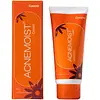What's inside
What's inside
 Key Ingredients
Key Ingredients

 Benefits
Benefits

 Concerns
Concerns

No concerns
 Ingredients Side-by-side
Ingredients Side-by-side

Water
Skin ConditioningEthylhexyl Methoxycinnamate
UV AbsorberMethylene Bis-Benzotriazolyl Tetramethylbutylphenol
UV FilterIsononyl Isononanoate
EmollientJojoba Oil PEG-8 Esters
Skin ConditioningCyclopentasiloxane
EmollientHydroxyethyl Urea
HumectantSteareth-2
EmulsifyingSaccharide Isomerate
HumectantLaureth-23
CleansingBiosaccharide Gum-1
HumectantPEG-20
HumectantPhenoxyethanol
PreservativeEthylhexylglycerin
Skin ConditioningAcrylates/C10-30 Alkyl Acrylate Crosspolymer
Emulsion StabilisingTriethanolamine
BufferingDimethicone Crosspolymer
Emulsion StabilisingDisodium EDTA
Sodium Lauryl Sulfate
CleansingParfum
MaskingWater, Ethylhexyl Methoxycinnamate, Methylene Bis-Benzotriazolyl Tetramethylbutylphenol, Isononyl Isononanoate, Jojoba Oil PEG-8 Esters, Cyclopentasiloxane, Hydroxyethyl Urea, Steareth-2, Saccharide Isomerate, Laureth-23, Biosaccharide Gum-1, PEG-20, Phenoxyethanol, Ethylhexylglycerin, Acrylates/C10-30 Alkyl Acrylate Crosspolymer, Triethanolamine, Dimethicone Crosspolymer, Disodium EDTA, Sodium Lauryl Sulfate, Parfum
Water
Skin ConditioningCyclopentasiloxane
EmollientPanthenol
Skin ConditioningPEG/PPG-18/18 Dimethicone
EmulsifyingGlycerin
HumectantHydrogenated Polyisobutene
EmollientBetaine
HumectantSodium Hyaluronate
HumectantAllantoin
Skin ConditioningCopper Gluconate
Skin ConditioningDimethicone Crosspolymer
Emulsion StabilisingXylitylglucoside
HumectantAnhydroxylitol
HumectantXylitol
HumectantMagnesium Aspartate
Skin ConditioningZinc Gluconate
Skin ConditioningPentylene Glycol
Skin ConditioningMagnesium Sulfate
Phenoxyethanol
PreservativeHydroxyethyl Acrylate/Sodium Acryloyldimethyl Taurate Copolymer
Emulsion StabilisingCarbomer
Emulsion StabilisingEthylhexylglycerin
Skin ConditioningWater, Cyclopentasiloxane, Panthenol, PEG/PPG-18/18 Dimethicone, Glycerin, Hydrogenated Polyisobutene, Betaine, Sodium Hyaluronate, Allantoin, Copper Gluconate, Dimethicone Crosspolymer, Xylitylglucoside, Anhydroxylitol, Xylitol, Magnesium Aspartate, Zinc Gluconate, Pentylene Glycol, Magnesium Sulfate, Phenoxyethanol, Hydroxyethyl Acrylate/Sodium Acryloyldimethyl Taurate Copolymer, Carbomer, Ethylhexylglycerin
 Reviews
Reviews

Ingredients Explained
These ingredients are found in both products.
Ingredients higher up in an ingredient list are typically present in a larger amount.
Cyclopentasiloxane, or D5, is a silicone used to improve texture of products and trap moisture.
D5 is considered lightweight and volatile. Volatile means it evaporates quickly after application. Once evaporated, D5 leaves a thin barrier that helps keep skin hydrated.
It is also an emollient. Emollients help soften the skin and prevent water loss. Silicones create a silky texture in products. D5 helps other ingredients become more spreadable.
Studies show D5 is safe to use in skincare products. We recommend speaking with a skincare professional if you have concerns.
Learn more about CyclopentasiloxaneDimethicone Crosspolymer is a silicone created by modifying dimethicone with hydrocarbon side chains. Due to its large size, it does not penetrate skin. It is considered non-occlusive.
Dimethicone Crosspolymer is used to stabilize and thicken products. It also helps give products a silky feel.
Ethylhexylglycerin (we can't pronounce this either) is commonly used as a preservative and skin softener. It is derived from glyceryl.
You might see Ethylhexylglycerin often paired with other preservatives such as phenoxyethanol. Ethylhexylglycerin has been found to increase the effectiveness of these other preservatives.
Phenoxyethanol is a preservative that has germicide, antimicrobial, and aromatic properties. Studies show that phenoxyethanol can prevent microbial growth. By itself, it has a scent that is similar to that of a rose.
It's often used in formulations along with Caprylyl Glycol to preserve the shelf life of products.
Water. It's the most common cosmetic ingredient of all. You'll usually see it at the top of ingredient lists, meaning that it makes up the largest part of the product.
So why is it so popular? Water most often acts as a solvent - this means that it helps dissolve other ingredients into the formulation.
You'll also recognize water as that liquid we all need to stay alive. If you see this, drink a glass of water. Stay hydrated!
Learn more about Water